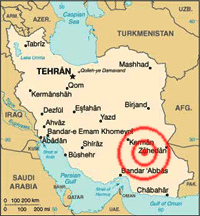 |
Assistance for Iranian Earthquake Victims

According to the U.S. Geological Survey, on December 26, 2003, at 05:27 local time, an earthquake measuring 6.6 on the Richter scale struck southeastern Iran's Kerman Province. The epicenter of the earthquake, with a depth of 10 km, was near the city of Bam, 180 km southeast of the provincial capital of Kerman and 975 km southeast of Tehran. To view a PDF map illustrating the population directly affected by the earthquake, click here.
According to the USAID Disaster Assistance Response Team (USAID/DART), the GOI estimates that 85 percent of buildings have been destroyed in Bam and the surrounding area. Out of the original population of approximately 115,000, the Government of Iran (GOI) estimates that 45,000 people are homeless, and this number is expected to rise to 75,000 upon the return of those currently staying with relatives or being hospitalized outside Bam. According to the United Nations Office for the Coordination of Humanitarian Affairs, (UN OCHA), the GOI estimates the earthquake resulted in the deaths of 30,000 people and injured 30,000 residents.
According to the USAID/DART, priority needs are water and sanitation, internally displaced persons, and shelter.
|


